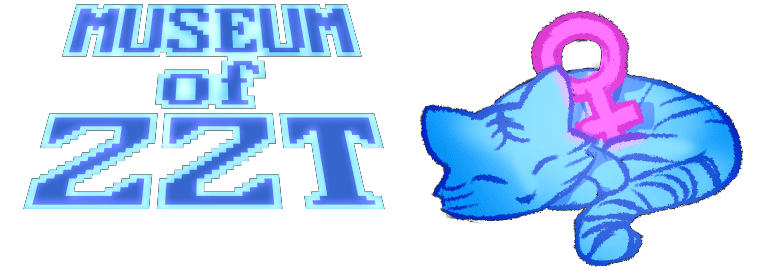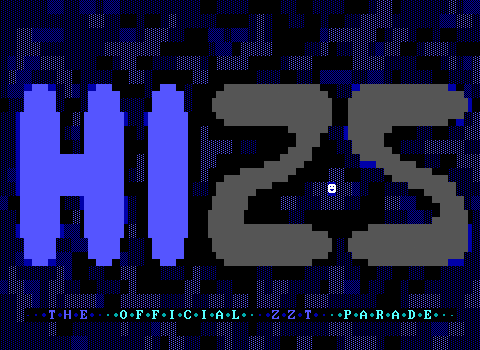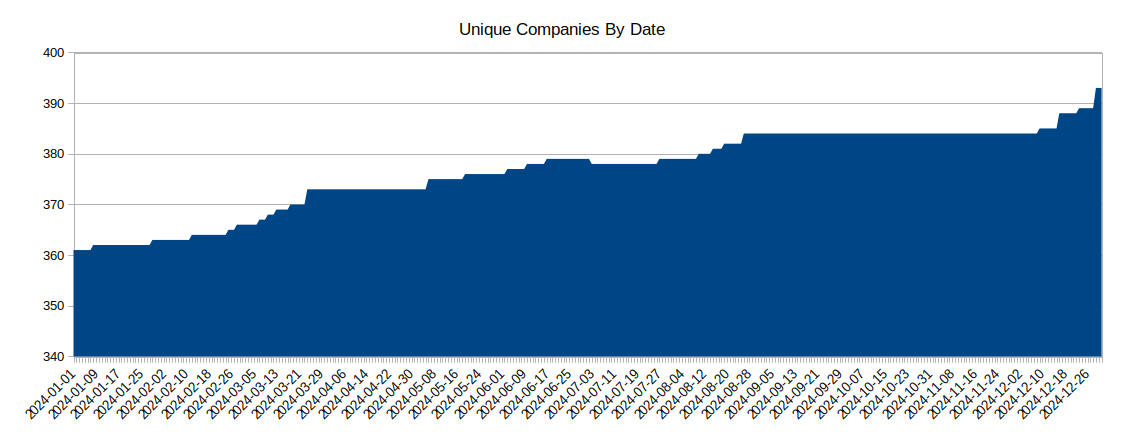The Nightly Stats
Queue Size By Date
How well did I manage to publish uploads in a timely manner?
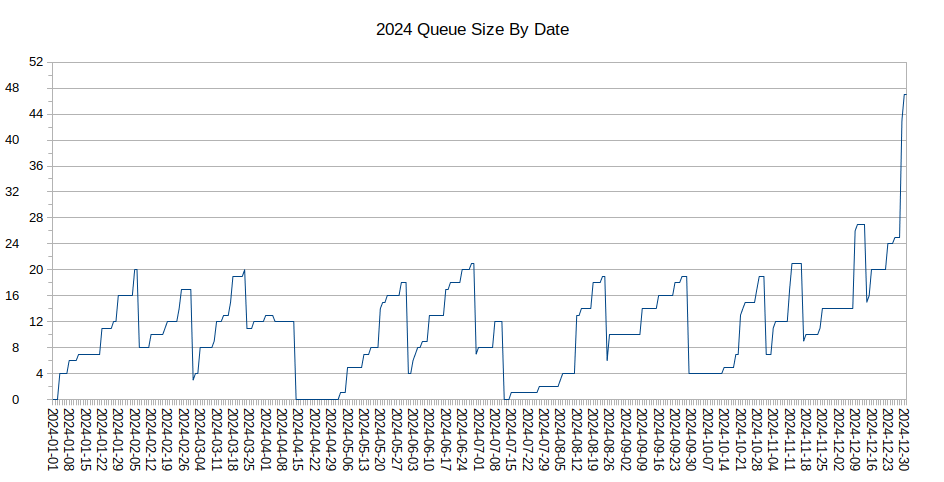
The story here is the usual. January starts with a clean slate, but it's not long before someone snags the title of the first new release of the year. More files are added, the queue gets too big for my liking, and things get published. Rare moments manage to empty the queue, with what I think is a new record in 2024 with zero uploads awaiting processing from April 14th until May 2nd.
Oktrollberfest blended in surprisingly well this year. I always try to keep the queue low going into October in expectation of jam submissions. This year, it took awhile for them to show up, which combined with a smaller turnout and number of non-ZZT entries being submitted meant that there wasn't a chance to do the early batch of entries and the later batch of entries. Some weren't published until well into November. Oops.
Queue Size Averages
It's a fun roller coaster of a graph yeah, but it's difficult to say how well the queue is being managed when looking at daily values. On a whim, I opted to calculate the average queue size for each month of the year.
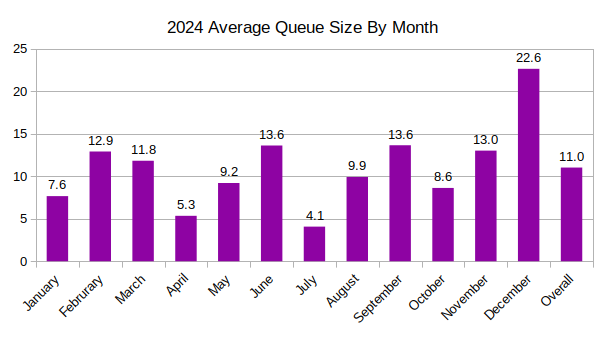
This gives a clearer indication of how on top of things I am when it comes to publishing. I don't like keeping new releases sitting in an unpublished state (except when they keep getting more and more replacement uploads), nor do I like having a queue that hits a second page. Way back in 2021, having multiple pages of files waiting to be published wasn't uncommon at all. Since then keeping things down to a single page has been the norm, with rare moments of an empty queue or two-pager being a bit rarer. This year went rather well, making it all the way until December before hitting a second page, and then falling into chaos with WiL's end of year upload spree nearly taking us to a third!
It's a de facto standard to publish in batches of twelve by default, so seeing most months' averages falling below this threshold, as well as overall average for the year makes me feel pretty good about publishing. There's still definitely room for improvement, some new releases did linger longer than I feel they should have, but a tiny bit more effort for this year should bring the average down even more.
...once I clear the initial backlog of WiL uploads.
This chart is a new one for this article, but I did look at last year's queue size stats to compare the year's average. The average size went from 14.62 to 11.01. Not bad at all.
Number Go Up
If these ever go down, something horrible has happened.
The Museum of ZZT: It has more stuff than last year™
Using Ana as the traditional benchmark of where z2 ends and the Museum of ZZT begins gives us 2,388 pre-Museum files. For files uploaded through all of 2024, there are 1,722 unique to the Museum. That means that 41% of files in the archives here cannot be found on older archives. It's a little unfair to z2 since obviously people aren't uploading their new releases there anymore, but the amount of worlds recovered and created since the old community came to a stop is an incredible success story. ZZT continues to thrive. Its history continues to entertain. Its new releases continue to push the boundaries of textmode gaming.
In particular, the author count really shot up this year thanks to the one-hit wonders in Wildcard streams. There were a lot of never before seen names who made a single game, and had to wait patiently for 30 years to be seen again.
This happens with companies as well, and while I don't want to slap a bunch of given (and possibly outdated) names, I am down to share a few of the high quality names people came up with for their little semi-real game studios that made an appearance in 2024.
- Death Defyer Products
- Doobie Games Incorporated
- Frogware Productions
- The Mike Company
- Sonic Studios
- WHIZZIWIG Inc.
- WORSE ZZT
Feel free to send them some contract work.
Museum of ZZT: Unlocked
A few uploads from throughout 2024 that made their mark on me.
“Awful Dates Done Quick: Samantha's Heart Freely Flies Away” by RT-55J (2024)
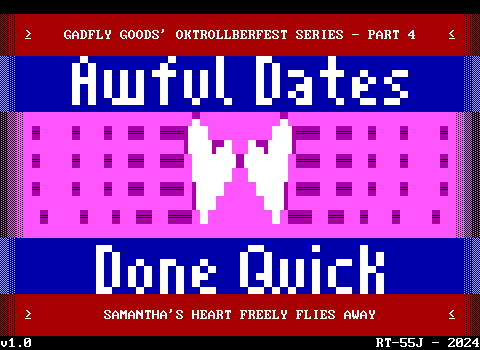
Going alphabetically lest I be seen as ranking these games rather than sharing them, the first game is a new Oktrollberfest classic. One that apparently scored last place thanks to non-traditional criteria and Itch's weird rating system that works best when your jam receives between 134-146 submissions and each entry receives between 19-21 ratings.
It's a known thing that Itch's scores rarely reflect the hearts and minds of the community members.
Screw the results. Awful Dates Done Quick is one of the all time finest games the Oktrollberfest tradition has given us. Far more than another game with surprise instant deaths or purposely bad design to make you wish you were playing something else, ADDQ delights from start to finish, with its trolls being done by subverting some expectations and being surprisingly literal with others.
The name alone is carefully crafted to give you the wrong idea. A dating sim in ZZT starring RT-55J's recurring Samantha Arantes character seems like a winning combination, goofy enough to be a game the participants would simply have to see, only to begin with a young Samantha starting her first day at a new school. RT continues doing what he does best, creating beautiful interiors for playable boards, and highly expressive and cartoonish art for static scenes. Gags are everywhere and all the while you'll be wondering how this will have anything to do with dating.
Only for the game to then cut back to the present and the dating sim aspect to now make sense as Samantha agrees to try out a local speed dating event.
Unfortunately, a runaway vehicle is unable to swerve away in time, striking Samantha as she crosses the street, isekai-ing her into another world!
This new world for her, isn't so new for those who have been keeping tabs on modern ZZT worlds. Samantha winds up waking up in the body of Goodfry Gadfly, from RT-55J's submission to The 2020 selectbutton.net Jam of ZZT. His world is expanded on and given a new purpose as a large bird has besieged the town, with Samantha taking it as her purpose in this world.
Hijinks obviously ensue, as the far more cowardly (or self-preserving) Goodfry finds himself awakening to a second consciousness in his brain. One that is far more bold, far less familiar with insect customs, and much more willing to run into dangerous situations full speed ahead.
An expertly done final confrontation is not only one of the more impressive boss fights I've seen in ZZT, but the way it manages to unexpectedly tie in to the game's prelude depicting Samantha's past makes for an unforgettable scene. Coupled with so much detail in art and board design, it's hard not to appreciate just how much RT-55J excels at everything he does here.
I've had my quiet grumblings about Oktrollberfest before, lamenting that the one consistent event the community has been able to stick to since it's revitalization is the one where bad games are encouraged. Awful Dates Done Quick demonstrates that there's more to a good troll than making the player wish a ping-pong-path was a little shorter.
“Cold” by WiL (2024)
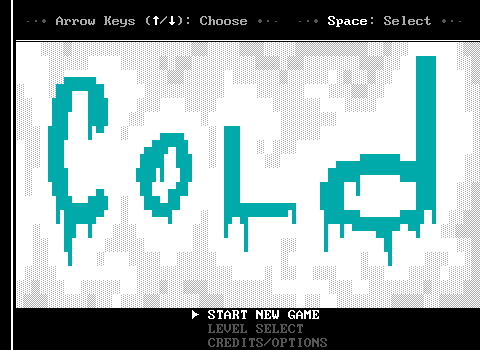
Cold is one of those Weave games that goes beyond what vanilla ZZT can do, but just barely, using fancier tech for a smoother presentation and more polished experience. It's the kind of game that could have been done in a lesser form in 3.2, but would involve some heavy compromise that would make it a much tougher sell to those playing the game directly on Itch, interacting with ZZT for the first time.
Cold brings wilderness survival to ZZT, drawing on Richard Evelyn Byrd's Alone: The Classic Polar Adventure" with a structure reminiscent of {% ml "https://museumofzzt.com/file/view/phoebus/" "Phoebus Project" %} on a much smaller scale. Cold tasks players with surviving in the most extremely low temperatures possible. (We're talking bordering on absolute zero here.) As with Phoebus your job is to collect data. In Cold, rather than freely roaming a strange planet in search of difficult to find chemometers, you are given a set of weather stations to visit each day instead. Your tiny cabin provides a map with clearly marked spots of where these are, with a eye-catching disclaimer that the locations are approximate and the map may be in need of updating from time to time, setting an initial tension that your visit to a station may not be as quick as you'd hope.
And speed is the only thing that matters in Cold. Donning your cold suit to brave the elements, an alpine landscape awaits with pine trees getting in your way, and patches of ice to avoid lest you get wet in deadly temperatures. Each day is a matter of planning your route at the map, and then dealing with the realities of how feasible it is to execute those movements. The longer you stay outside, the colder you get, with WiL using Weave to document a list of maladies ranging from numb toes to more horrific impairments like your eyes failing.
Thanks to Weave, these impairments can be depicted much more powerfully than a health value dropping ever closer to zero. You'll notice the intrepid explorer moving more slowly, requiring multiple attempts to manipulate his hands when gathering data, and the screen going gray with reduced vision as you pray you can make it those last few steps to your warm cabin's furnace.
As a survival game, it's impressive. It's no small feat to make it to multiple stations in a single trek. Finding a gap in the trees that saves you some walking provides a real sense of triumph when it allows you to persevere on some of the harsher days.
But Cold isn't designed to be a test of your skills. There's no celebration for completing your work quickly, nor any high score list to record your best times. The post workday evenings of Cold are punctuated with diary entries, recording the horrors not only of the cold, but of the realities of propane usage, poor ventilation, and a food supply consisting mostly of butter. (It's got a good calorie to mass ratio.) These diary entries document a slow realization that the conditions may be too much for any man to survive. The fear that something horrible is going to happen is practically telegraphed, with each diary entry then having a narrator referring to the diary and its writer in the past tense. The events of the game have already come to pass, and you are just living them, watching the fuel gauge dip ever lower, knowing that the thirty day excursion surely can't get that far. And if it can't, what does that mean for the player still happily collecting data, avoiding acknowledging the extent of the problems and the clear need for rescue?
“Freelance Dungeon” by dave2 (2024)
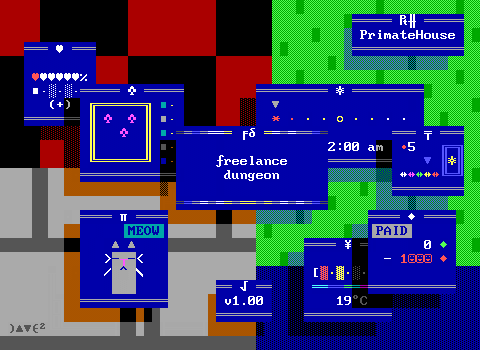
dave2's return to ZZT came as a surprise in 2022 when he arrived to do justice to an incomplete 24 Hours of ZZT entry 2003 with Oil, a last minute release for the year that was a definite favorite of mine. This year he once again brought his A-game with Freelance Dungeon, a limit-pushing 3.2 world that captures the spirit and humor of the 2000s ZZT community while keeping the darker aspects of that era in the past where they belong.
Freelance Dungeon is an engine game, but not in the usual sense of of a single engine being repeated again and again to create a construction kit for stages or RPG battles or whatever. This is a game full of systems to breathe life into a magical world filled with strange characters. Your beloved aunt has recently passed away and left you her home and cat ...as well as some substantial debts. In order to pay the bills, you take on work as freelance dungeoneer, fighting through dungeons in search of treasures to haul back home.
Dungeoneering consists of a random level generator in your new home's basement, where a crystal is used to open portals to dungeons for easy pickings. The rooms it produces are simple compared to more modern random designs like those seen in KKairos's Computer Dungeon Slash, being more similar to KKairos's Dungeon Guru Nostalgia Maximum. This makes sense given the limited room to cram a level onto an already packed board, and the fact that there are so many other systems running in the house that leave the game with almost no memory to spare.
So if it's not the dungeons themselves that make Freelance Dungeon such a noteworthy release, then what is it about the game that makes it appear on this list?
It's the systems stupid!
The other popular genre of the 2000s that dave2 runs with are life simulators. A number of authors bit off more than they could chew in this era trying to adapt The Sims to ZZT in some form, and they all pretty much failed to make anything compelling. Dave pulls it off, thanks to tight integration with the rest of the world. You have to eat and sleep, but these processes are much more nuanced than resetting your health to 100 or setting the clock from night to day. You can rest as long as you need for health, having to bear in mind that the rest of the town will be asleep when you should be. Food offers varying benefits, and you're not just cooking for one!
Your aunt's cat needs to be cared for. They'll run around the house on their own throughout the day, while checking their food bowl before settling in to your bedroom at night. Be mindful to let them out in the morning lest they make a gross mess on your bed. Treat them well and you can get a daily health boost from cat-related dopamine. I'm still in awe at how capable the cat is at navigating a very tightly packed home, especially when you can interrupt its code to pet them at any given moment.
You'll find benefits to drinking tea, but will need to be sure to make it to the bathroom not long afterward. Yes, after all these years of ZZT toilets, dave2 finally went and turned the player's bladder into a gameplay consideration, so make sure you plan a break between dungeon dives!
And remember to shut the lights off before you leave your home! The last thing you want in an inflated power bill because you will be receiving all kinds of randomly selected mail over the course of the game.
Then there's the world outside your home. dave gives the players a short walk to town with fish to harvest and trees to prune for firewood that slowly refresh each day. The town has a number of characters ranging from shopkeepers to an old friend of your aunt's, and if you can win him over, you may befriend a goblin by the name of Kroblin. Here dave also shines, with some very well written characters who absolutely know how to make you laugh even when you're just buying a better orb to ponder for higher paying jobs.
Freelance dungeon succeeds where so many games of the 2000s failed, managing to create a game with an immensely colorful aesthetic that's loaded with systems to figure out in order to succeed, whose technicalities are counter-balanced by classic ZZT run and gun action in the dungeons. Rather than take the fool's errand of simulating 21st century life in ZZT, dave cleverly went with fantasy instead, making it easy to sand down the rough spots where the realism is inevitably going to be lacking and turn them into part of the charm of the game's world. It's a simulation that ZZT can handle, while still being impressive to the point where you likely wouldn't think it could. He makes it look easy, and the resulting game is a must play, especially for those from the olden days who will be in awe upon seeing the boundary that marks ZZT's limits pushed back ever-farther.
Now if you'll excuse me, I'm going to brew some tea. Unfortunately, I'm all out of wizard's cheese.
“Galactic Foodtruck Simulator 2999 v1.8.21” by LOVELOVEKITTY, WiL (2024)
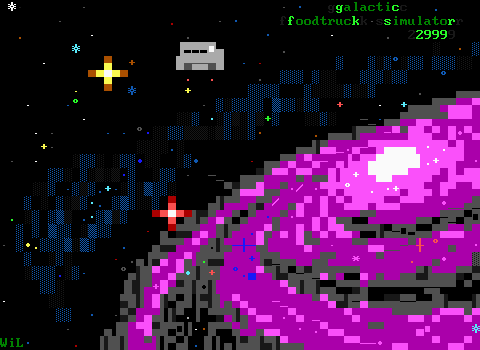
Program Description
The year is 2999. You have 40 weeks to establish a thriving mobile restaurant business and begin paying back your creditors.
Gee Dos, how come WiL gets to have two entries on this list?
Well, because he really nailed it this year, book-ending 2024 with two excellent releases that are so different from one another that I'd never be able to decide which one to quietly namedrop while discussing the other.
While Cold may leave you daydreaming about what the same game would have looked like had it been made twenty-five years earlier, Galactic Foodtruck Simulator 2999 could have only come from the modern day.
In the beginning, the game appears to be a humorous sci-fi take on the BASIC classic Lemonade Stand. Amass some ingredients, combine them to form recipes to cook, set your price, and park your truck where customers will gather. There's quite a lot that builds on the premise to keep it fresh and engaging regardless of its simple gameplay loop. Recipes discovered are tracked with bonus rewards earned for creating specific numbers of the game's forty-five possible dishes. The perks keep the game from feeling repetitive, as you'll always have more to consider than the one dish that does best at each location.
Ingredients need time to refresh, keeping players from parking on a single planet and never exploring the rest of the galaxy. A number of upgrades are available to purchase to increase your max supplies, provide for better harvests when acquiring them, and expanding the number of dishes you can prepare at a time. Additional staff can be hired via an incredible resume system to allow more to be done in less time.
This alone is plenty to leave those BASIC programmers drooling, but the game also excels in its presentation. While still a ZZT game controlled via keyboard, the game's interface is highly visual, pictures of planets, large icons for ingredients, randomly generated customers all give the game an incredible flourish that will be seen as something to strive for with Weave for years to come. WiL's previous high-tech Weave game ZoZ seems almost spartan in comparison. The humorous tone here also makes the game rather welcoming. There's little reason to fear making mistakes, as a wasted day of sales is a far more gentle penalty than burning ZoZ's expensive trinkets which had infrequent opportunities to replace them.
For your non-ZZTing friends, GFS is not only approachable enough that those who would scoff at ASCII graphics will find themselves charmed, but it's also complex enough that it will quickly get them to understand ZZT's appeal in the first place. ZZT's past has a number of unique experiences to offer, but it's hard to escape the stigma of "Yeah I can see why this resonated with folks who had crappy computers in 1999." The game breaks free of the "by ZZTers for ZZTers" mentality that doesn't bother trying to engage non-community members, and instead can easily be treated as a comedic, high quality game with so many surprises in store for those who stumble across it on Itch.
And I didn't even touch on the ways the game does so much more than being Lemonade Stand Plus. There are constant events happening over the course of the game with your decisions, supplies, and ability to keep promises having a dramatic effect on your truck's success, and its ability to pay off the ever looming threat of a loan becoming due. By the end of GFS you'll be cheering on and cheered by a number of intergalactic characters, being asked to cater weddings, inviting tree-folk to live with you, and becoming a king of social media.
“An Ilford Conspiracy” by Toby Norfolk-Thompson (2001)
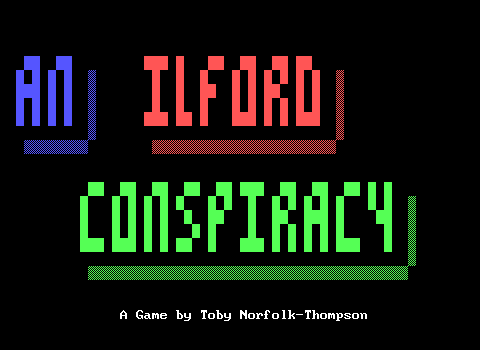
The bulk of games found via asie's archival efforts have been 90s titles, particularly AOL-era as these worlds were relatively widespread at the time. As the community consolidated in the late 90s, cemented when z2 became the definitive website for all ZZT community activity, unpreserved worlds from the 2000s became much more difficult to find. There were fewer to begin with thanks to z2 being the center of the ZZT universe, but that means that while plenty of ZZTers around in the 90s can tell you all about games they remember playing that have yet to be recovered, the lost works of the 2000s tend to be complete unknowns until they show up out of nowhere.
An Ilford Conspiracy is one of these worlds, an outsider game intended not for the teenagers and young adults that knew to respond to a YAY SIRS with an OHH DEAR, but one designed for a small friend group attending university together in Ilford. Seemingly created with no knowledge that ZZT had a decade long history of works to learn from, An Ilford Conspiracy becomes an evolutionary branch none had seen before.
You tour around the city, maintaining your social life, attending parties, going out for kebabs, and trying to find romance in an incredibly abstract depiction of Ilford itself. The game uses no STK (so z2 staff would have rejected it anyway). Instead, eschewing the realism that ZZTers obsessed over with their grays and browns in favor of a highly minimalist design, with what would be busy city streets being depicted through a scant number of multi-color walls. The game is full of black empty backgrounds for both the outdoors and interiors, while objects that aren't NPCs being few and far between.
The game revolves around a kidnapping of one member of your friend group, a plot which quickly takes a backseat as you find yourself saving your favorite kebab shop by burning down its cheaper competitor, using spy gear to make sure your friend can be the one wearing the fanciest dress to a party, and trying to acquire a James Brown album to make oneself more appealing to chicks. (They just dig James Brown.)
It's a radical departure from the friend group games seen before. Here the problems are the real struggles of the 20-something in the 21st century, during the time when the phone booth was endangered but not yet extinct. It feels quite different from the 90s take on the concept where you and your friends all have a big mansion and all the video games and have to stop aliens from taking over the world. Ilford is a time capsule with some high quality writing certain to convince players to keep scouring the world for more information and items, and allowing you to talk with a number of believable characters based on real people.
It suffers a bit from confusing navigation (Though I'm sure the underground stops make perfect sense to the natives), and if I recall correctly a genuine passage error prevents the game from being completed cleanly, yet it's hard to complain too much when the game feels like it could have come out only yesterday. An Ilford Conspiracy is one of the best examples of the importance of combing the web and backups for lost worlds, delivering us an unknown author's passion project so far removed from the norms of 2001 that you'll wish there was more like it now.
“Rescue” by awebs (2002)
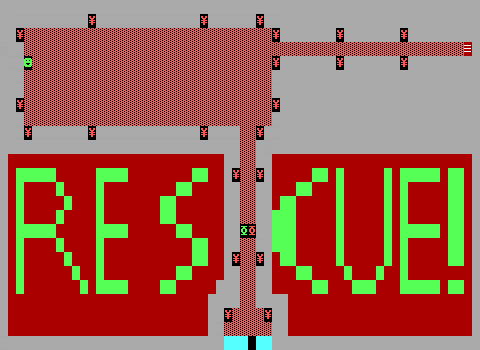
When digging through old forgotten worlds, whether they're uploads of files that haven't been available since the AOL archive days or files that have been collecting dust since then, one of the best signs that a game will be worth showcasing is if it's obviously made by a child. ZZT opened the door for so many kids to create video games for the first time, and the complete lack of compromise those kids are willing to make to their vision always leads to some of ZZT's greatest moments. Just because the borders are yellow, the objects all shout simultaneously when you enter the room, and a giant centipede is the only danger you face doesn't mean there's no hope for such a game.
Young authors have the loftiest ideas in their head, and when faced with the reality that they cannot remotely capture what they've imagined in any form recognizable to players they simply shrug and ignore it. Instead of scaling back or studying more complicated worlds, they continue to create their vision as best they can. It's catharsis for them, and often comedic for the audience.
But games like Rescue are more than just cheap laughs at silly storylines that require extreme suspension of disbelief. They're full of passion and an unflinching desire to create something on equal to the games they love. Rescue is one such author's magnum opus that was able to escape the confines of imagination and become something they can play, share with their friends, and release to the outside world. When you make something with ZZT, you're no longer dreaming of making the next Mario, Minecraft, or Bluey: The Video Game, you are now on that level. You make games.
Rescue, which I desperately need to start actually talking about at this point, is one of those epic creations where the author managed to pull it off. Clocking in at over ninety boards, it's a gargantuan tale that begins with a child venturing into a cave who has yet to return. You play as an unnamed hero who simply agrees to help the boy's timid father rescue his son simply because you were there to help. What follows is dozens and dozens of boards broken into levels, with a plot that slowly gets more and more bolted on to it, turning a cave rescue mission into a battle with evil robots for the future of humanity.
Typically when an author has a lengthy period of working with ZZT, you can watch their skills grow from game to game. Scrolls and piles of monsters give way to dedicated objects and more unique enemy placement. Visuals improve from blocks of solid color to more eye-pleasing patterns or perhaps some really fancy art boards once STK is discovered. In Rescue, this all happens over the course of a game.
Very simple and amateurish looking boards await players in the first level, becoming more refined and original as the game goes on. awebs goes through these little phases, discovering more about what ZZT can do, both as intended and as discovered by its userbase. An early love of spinning gun gauntlets gives way to running across landmines (unmoving bullets) after grabbing an energizer. Levels begin to sprawl, requiring keys to be found on different boards rather than taking each screen as an individual challenge.
You can pinpoint the exact moment where awebs learns about the ZZT Encyclopedia, when suddenly player clone powered teleporters warp players to different boards, a tremendous leap forward in complexity unmatched anywhere else in the game. When you finish the game, it gives a special cheat code to play the game in "fast mode", utilizing the cheat prompt to manually set a flag. An entire legacy is crammed into a single adventure.
And the best part of it all is that awebs has plenty of good ideas. Early on, you may be wary of what toll 100 boards of "this" will take on you, but because he continually improves, the game is enrapturing. There's a ton of variety to be had and plenty of well thought out layouts that give players a real sense of accomplishment when you get through them. Most worlds that approach ZZT's board limit would be improved by pruning a significant number away, but Rescue surprised me most by never getting dull, easily making it one of my favorite finds of the Wildcard streams for the year.
“Weaver Pixel Twenty-Eight” by Noser (2024)
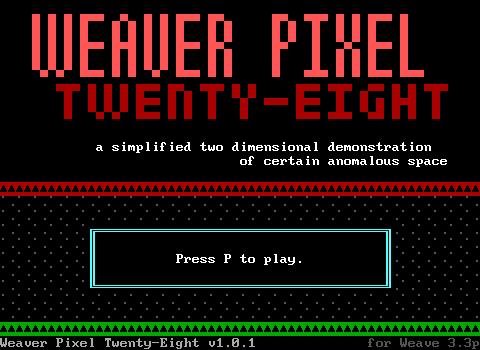
Program Description
Flip gravity to guide the yellow pixel to the white goal. A physics action game for WeaveZZT with connections to Gravver and Hover-Pixel 384.
wp28.zzt is the main version. As it uses WeaveZZT features for animation in an unusually CPU-intensive way, wp28alt.zzt is included as an alternate lower-CPU-usage version.
WiL has said of Weave that much of what you can do with it could be done with vanilla, with the real constraints being memory limitations more than anything else. Weaver Pixel Twenty-Eight puts WiL's suggestion to the test, beginning life as a Weave exclusive to see just how much "physics" ZZT can handle. Via a custom character set, a single pixel (1x2) can be positioned in fifty-six possible arrangements of a single character. This pixel can then bounce remarkably fluidly, moving within the cell as needed, and then moving along the grid as objects typically do when it crosses a boundary.
Your task is a simple one. Guide the ball to the exit. A single button is your only method of manipulating how the ball moves, with the space bar bound to flipping the direction of gravity for the physics engine. Through this you get to thread tiny gaps by flipping gravity repeatedly, pump the brakes before plunging into lava (be it on the floor or ceiling), and astound yourself when you just barely find the correct angle to ricochet through a series of gaps with no further intervention needed.
While it may be nothing more than a tech demo on the surface, once you get past the initial learning curve of the physics minutiae and the cooldown between flips of gravity, you'll discover the game is much more than that. Far from slapping together some rows of lava and walls with gaps in them, the level design amps up the difficulty and feels lovingly designed to push players just a little bit further with each stage. This is a game that on stream I was ready to quit for the night, and then found myself still playing half an hour later because I didn't want to stop.
And then, now equipped with knowledge of exactly what would be needed to be done to model the game's physics, Noser went back to ZZT v3.2 and released Unwoven Pixel, now a much easier to develop de-make of the original game with a scaled back scope. By focusing on the Weave version, noser was able to spend more time designing levels, and less time debugging a flaky engine. The doubters who worry if Weave is "still ZZT" should look to this pair for the answer. Weave allowed the author to realize their vision faster, develop it further, and allow for more levels with fewer constraints. How you create isn't as important as the results, with Weaver Pixel Twenty-Eight still managing to turn heads, only this time, unlike other efforts at doing more with ZZT than thought realistic, it did so while ensuring the game itself is something to appreciate on equal terms. Now we get the best of both worlds, proof that ZZT hasn't run out of new tech, and a new game with a concept you'd get hooked on after stumbling across it on an MS-DOS era shareware CD.
“Weekend of ZZT February 2004 [Sacrifice]” by Mooseka, Various (2004)
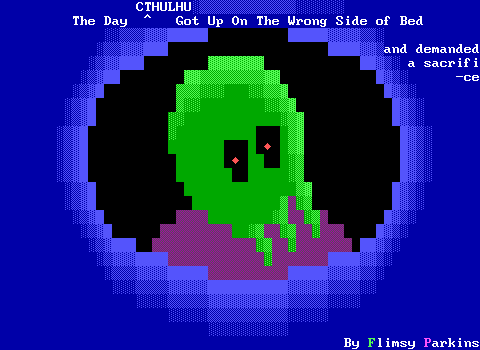
The 2000s can be a rough time to look back on when it comes to ZZT games, as it often means staring in the abyss and having it stare right back. If I can remember being around for it, there's a good chance that it's now a bomb that requires an extremely delicate approach in order to discuss. Script dumps are scanned, unused boards are browsed in advance, and sometimes you may find something reprehensible added in a comment of all things! Yet, despite the needless aggression and hostility of the era, there's still a lot of wonderful creations to be rediscovered, especially in the forgotten domains of Weekend of ZZT compilations.
The contest begin as a successor to the 24 Hours of ZZT contests which fell out of favor as people found it harder to dedicate an entire day to making a ZZT game resulting in low turnouts and a flood of junk entries to troll the judges they knew would have to play them. A 72 hour time limit was agreed on to provide a more flexible schedule and hopes of higher quality games without having to rely on last minute crunch to get something submitted in a single day.
And this first such competition absolutely succeeded! Not only was the overall quality higher than that of shorter contests seen before, but a number of the submitted games still hold up quite well today.
You get TTTPPP's "Sacrif ice ice baby" where a humble servant must plea with a god to save his wicked master that has fallen ill. In order to make up for all his sins, a number of items must be sacrificed. The game takes the form of individual puzzles to acquire these items with a lot of variety making the game a great showcase of the kind of puzzles you can make with ZZT. You'll tie shoelaces, escort grain and animals in a boat, make trick shots at fish in barrels, and more. (Less good is the Simon game which seriously expects you to input a sequence that grows to a disgusting thirty inputs long. Cheat past that one. It's not worth it.)
Commodore's "The Damned" is a light dungeon crawler through a demonic realm after you have been sacrificed. In order to escape the world of demons you need to fulfill your destiny and find a holy sword with which to fight off the horrors.
One of the cooler parts of the game is that occasional switch to a first person perspective when examining certain objects to interact with them in detail. The game gets a bit Shadowgate-y, allowing items to use used and clues to be uncovered up close.
But the game that I found myself most wowed by was Chaos Warrior, a hyper-violent action game where you are a chaos-god worshiping warrior competing with other followers to be crowned the new champion of your god. It takes the bump combat seen in a number of fantasy-themed games that use melee combat and throws out all sense of challenge in exchange for overwhelming power. Your task is to raid a peaceful village and bring back more heads than anyone else. "Enemies", few of which have any ability to fight back, are slain in single hits, coating boards in gore as you collect their heads to cash in at base camp.
It's game where your only real adversary is the timer, making the game incredibly fast paced compared to dungeon crawlers it might be compared to where you tend to methodically fight through darkness. The village has some citizens that try to fight back: town guards, a tower filled with wizards (and your god just hates magic users), as well as clerics of the local church. They're all prepared to give their lives to defend the town, but to a brute such as yourself, they offer little meaningful resistance.
An upgrade system allows you to buy stronger weapons and armor for those few foes that aren't pushovers, as well as embracing the chaos a little and allowing you to pray for mutations to make you stronger! A very unique game that works remarkably well.
“Zuzatan: The Forgotten City” by authorblues (2024)
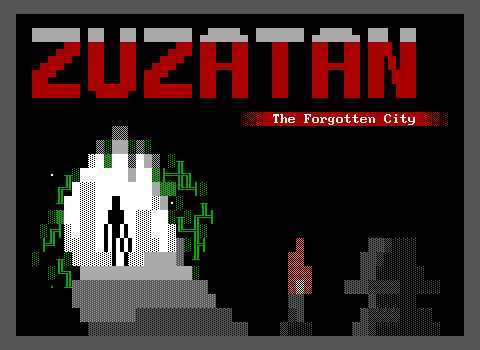
authorblues, a self-described "Bad Games apologist" and "La-Mulana superfan" poked around with ZZT a bit on stream a few years back, and was quickly enraptured by everything about it: The original worlds, the years spent by ZZTers creating game after game, and of course the ability to make something in what is now seen as a very constrained medium for game design.
He arrived in the Discord and soon found himself hard at work on creating his own game, regularly asking questions on how to achieve certain effects, how one would go about designing a custom character set for a game, and in return dropping the occasional screenshot of his work in progress, slowly building up the anticipation for what he would eventually release.
Zuzatan is its name, and what authorblues delivered with it is a captivating adventure filled with puzzles to solve, secrets to discover, and a story that tells the tragic tale of an exiled group and their struggle to return home. This story starts quite differently for the player, a grad student at an archaeological dig site where they've been tasked with finding a missing professor. The ruins of Zuzatan, a lost city filled with mysteries of the people who lived there and the fate that befell them quickly transforms from a potential stage in Commodore's Super Archaeologist Simulator into an atmospheric journey where for every answer found in the ruins, more questions are raised.
The ruins are no safe place for students. Packing some extra ammunition (as all students of archaeology do) can help you deal with the snakes, sure, but the real danger comes from the traps. auth quickly trains players to keep an eye open for anything amiss. Noticing an odd indentation in a wall can be the difference between survival and a grisly death by spikes, spears, or fire. It's also essential if you want to make any real progress in the ruins, as locked doors and passageways can only be handled by solving puzzles to acquire keys and change the state of rooms.
The puzzles are certainly the star of the game. The La-Mulana influence means that nearly every board has some secret to uncover, with a few cryptic hints to decipher once you're able to use your laptop to translate the Zuzatanian texts etched onto stone tablets across the ruins. Often, when you think a board has no purpose beyond connecting one branch of the cave system to another, you'll discover an hour later that there is a trick to perform to reveal yet another path.
It's a rare instance where note taking is strongly encouraged if you want to reach the end. Puzzles are often cryptic enough that you can't even begin to realize what you should be doing until you've come across something else later, and the game just keeps on going, delivering more and more story, puzzles, and shortcuts to create an elaborate network of tunnels that connect the underground ruins.
If you want a game that can really keep you busy for more than a single afternoon, Zuzatan has much to offer those who would rather think with their brain than their gun. It's easily one of ZZT's most well constructed puzzle games. authorblues's ability to make the game so much more than a collection of riddles to unravel really demonstrates how in modern times, the games from new ZZTers can easily reach or surpass the works of the greats of long time creators.
“ZZT : The Next Generation” by Andy Schile, Leonard Richardson (1995)
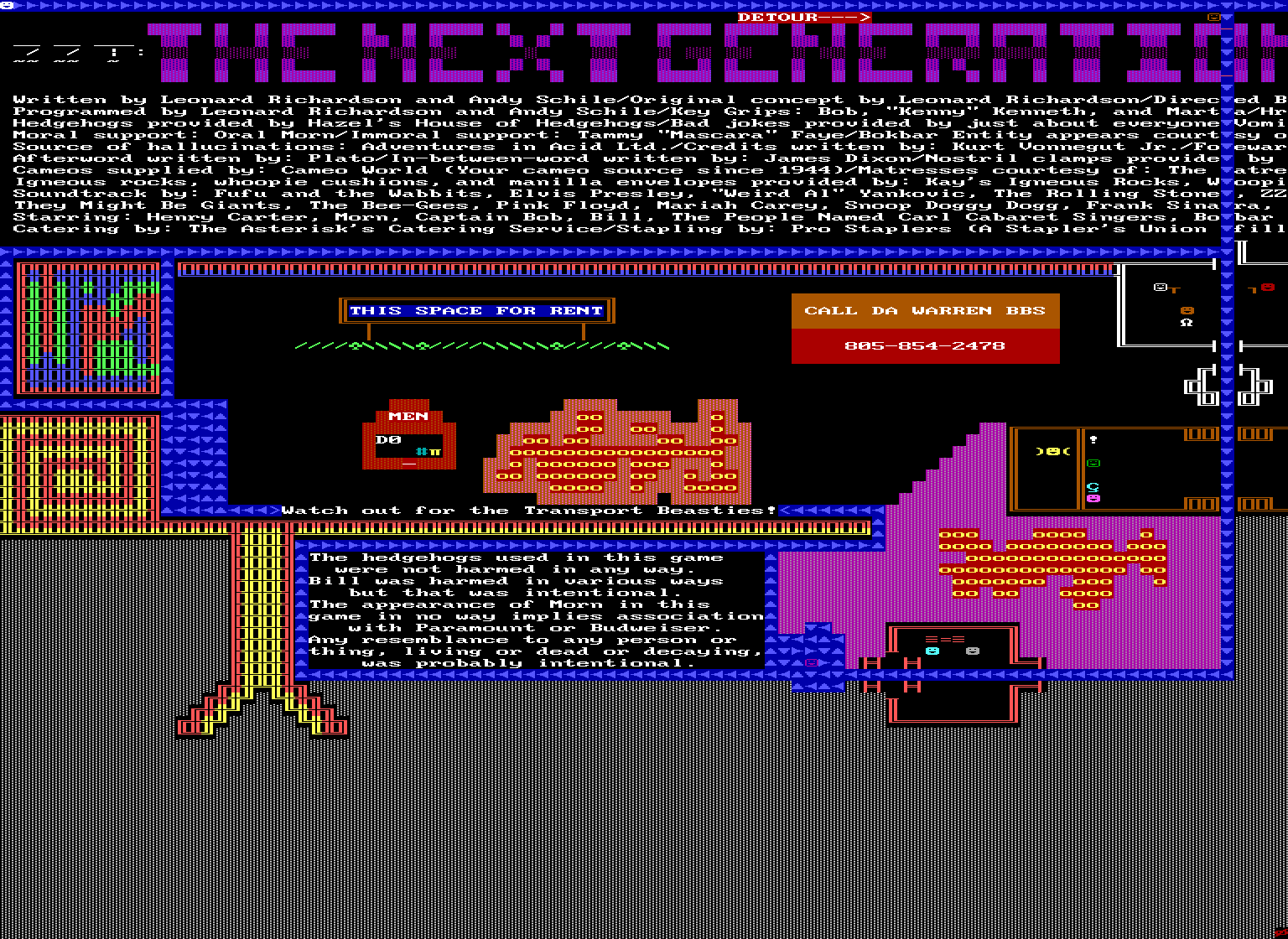
The third time's the charm, in what wound up being an incredible pull in the search for a Super ZZT world to play. This game was a natural choice of what to play after finishing its two predecessors for regular ZZT games:, ZZT: The House of Bob and The Mansion of Bill. Those first entries were simple games with an emphasis on 90s humor that struggled to land thirty years later. I went into Next Generation with low expectations. However, that put it in a prime spot to surprise me, and it truly did.
As it turns out, being made in Super ZZT is actually a real blessing. The platform is one that ZZTers do see merit in, but we're all quite ready to acknowledge that while 34 years of ZZT has led to hundreds of incredible creations that do so much more with the engine than you'd expect from Sweeney's original saga, most people's favorite Super ZZT game is still Monster Zoo or Lost Forest. 2016's Tyrobain aside, the average Super ZZT world never really did anything to make folks consider using its much unfriendlier editor.
To finally find a Super ZZT game that I can say I'm glad I played, and glad it was done in Super ZZT and not the original? That's significant.
Next Generation doesn't have the strongest start, following in its predecessor's footsteps of cracking jokes laser-focused on appealing to online humor in the earlier half of the 90s. Mostly harmless jokes that are as relevant now as humor about your VCR blinking 12:00. It looks like it's going to be more of the same, just with squarer characters.
However, once the game gets underway, there's a marked improvement. Instead of making a ZZT game with silly objects, Andy Schile and Leonard Richardson created a Super ZZT game about visiting strange places, and thanks to the oversized nature of Super ZZT's boards, they're packed with weird characters, and full of surprises to be revealed once the screen is scrolled far enough.
Though there is still some combat, the world is very much a fuck around and find out game, and that is where it excels. Your journey will bring you to various planets, which tend to be very 1990s Americana focused, but that plays better than 1990s Star Trek humor (save for Morn). There's an entire town to explore, complete with a massive mall filled with even more stores than seen in the previous games. Another planet focuses around a Woodstock inspired concert, full of side attractions ranging from "Software Pirates of the Caribbean" to a water tank to dunk Tim Sweeney himself into with a well aimed pitch. The game also contains what may very well be the first appearance of Snoop Dog in a ZZT game. Even its drug humor lands, when a drink of spiked punch makes you start seeing the walls covered in spiders, which then really happens thanks to Super ZZT's inclusion of a spider enemy that the walls indeed can be #changed into!
Part of it may be the mid-90s finally being a moment in time in which I have some actual memories. Knowing about Snoop Dog, Sonic the hedgehog, Weird Al, TV's Frank, and more certainly makes it easier to laugh at their unexpected appearances, but I also feel that the big difference is the jokes have risen above low effort puns to high effort puns, and less insistence that words that rhyme are funny on their own. And even if you're a bit too young to get some of the references, there's a lot of original material as well, really showcasing the authorial duo at their best. There are some excellent moments here. I'm still thinking of how the game establishes Andy's sister Lisa will be the boss of an area, and having to find a way to get her off the phone before she'll actually care about performing her role as a boss fight. Or the post-stream discovery where if you shoot at your reflection in the mirror you'll lose health for shooting yourself. It's a game that embraces being dumb, but in surprisingly smart ways.
I've never seen The Next Generation mentioned when discussing the history of ZZT comedies, but this one is clearly a major work that shouldn't be overlooked, and gives Super ZZT a desperately needed boost to its reputation.
The 2025 Prediction
Last year's prediction was a bust. We still don't have the original non-gold update of Sivion. Hope springs eternal.
My called shot for 2025 will be the original release of Rhygar, an incomplete trilogy whose first chapter only exists in Plus form. The text file suggests the changes are rather minor, but as with Sivion, there's a bit of annoyance that a game as influential and revered as Rhygar, has a missing earlier version that would let us see what people originally fell in love with.
Okay. I think you've had enough words for one article. Adios.
